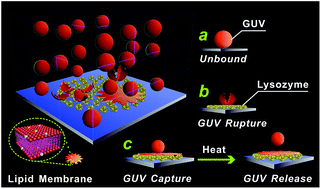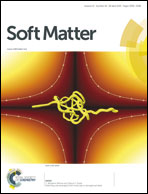Soft landing of cell-sized vesicles on solid surfaces for robust vehicle capture/release†
Abstract
Based on a concept of a smooth and steady landing of fragile objects without destruction via a soft cushion, we have developed a model for the soft landing of deformable lipid giant unilamellar vesicles (GUVs) on solid surfaces. The foundation for a successful soft landing is a solid substrate with a two-layer coating, including a bottom layer of positively charged lysozymes and an upper lipid membrane layer. We came to a clear conclusion that anionic GUVs when sedimented on a surface, the vesicle rupture occurs upon the direct contact with the positively charged lysozyme layer due to the strong coulombic interactions. In contrast, certain separation distances was achieved by the insertion of a soft lipid membrane cushion between the charged GUVs and the lysozyme layer, which attenuated the coulombic force and created a mild buffer zone, ensuring the robust capture of GUVs on the substrate without their rupture. The non-covalent bonding facilitated a fully reversible stimuli-responsive capture/release of GUVs from the biomimetic solid surface, which has never been demonstrated before due to the extreme fragility of GUVs. Moreover, the controllable capture/release of cells has been proven to be of vital importance in biotechnology, and similarity the present approach to capture/release cells is expected to open the previously inaccessible avenues of research.


 Please wait while we load your content...
Please wait while we load your content...